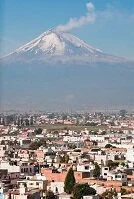Wildlife

Popocateletl Volcano
The wildlife in Mexico is quite impressive and it boasts one of the most diverse ranges of reptiles in the world. However the diversity covers all animals and the number of mammals, both large and small is incredible. Mexico is home to deer, sheep, bears, jaguars, bobcats, and more large mammals. There are also numerous smaller mammals such as monkeys, bats, anteaters, and tapirs. The mammals don't end at the land though; the waters surrounding Mexico are home to numerous whales and manatees. These waters and the inland lakes and rivers also host thousands of fish and shellfish.
The bird diversity is nearly as impressive as Mexico has parrots, owls, eagles, hawks, and numerous sea birds and migratory birds, including geese and cranes. Among the reptiles and amphibians are crocodiles, turtles, snakes, lizards, frogs, lizards, and iguanas. Finally, there are thousands of insects, most notably the butterflies, many of which migrate to Mexico each year to breed.